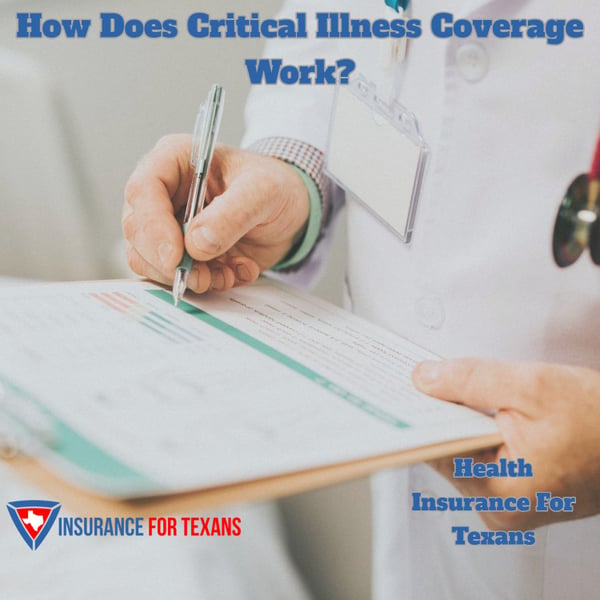As Texans search for alternatives to the current health insurance exchange plans, the subject of catastrophic health insurance comes up. Many Texans are seeking a different way to do medicine by attempting to limit the reach of the health insurance company and government in the delivery of their healthcare. When you do this, you still have to plan for bad situations that can create large medical bills. That's where catastrophic health insurance can come into play. A catastrophic health insurance policy is typically composed of three compartments.
- Critical Illness
- Accident
- Hospital Indemnity
The Critical Illness portion of the catastrophic health insurance policy is really a lynch pin to the success of the policy. These critical illnesses are some of the most debilitating health incidents financially. Treatments can become incredibly expensive.

Critical Illness Policy Definition
A Critical Illness health insurance policy is designed to cover your costs for the treatment of major illnesses and hospitalizations that arise. The list of critical illnesses covered will differ from one company to the next. However, most policies will cover stroke, heart attack, and cancer unless they are condition specified policies like a traditional cancer policy. Where the differences come into play are in things like gastrointestinal conditions like Chron's disease or circulatory conditions like a blood clot in the leg. The policy definitions will either have a specified list of conditions that it covers, or an open ended list and a specific list of conditions that it will not cover. It's important to understand which one you have and how it works. It's definitely not for conditions like flu, common colds, or other short term acute illnesses.
How Does Critical Illness Coverage Work?
The critical illness policy is NOT going to cover your visit to the doctor for an annual check up. That said, when you are diagnosed with a condition that is covered you can begin to receive benefits subject to the policy conditions. The conditions are made up of four components. The Deductible, Covered Amount, Coinsurance, and benefit maximums will determine how much and when the benefits will be payable.
The Deductible will be first dollars out of your pocket. They typically range from $1,000 to $5,000 and are up to you to pay. When the claim process begins, the bills will be totaled up and you will be responsible for this portion of the bill.
The Covered Amount is the percentage of the claim total that the health insurance company is going to pay. This is typically a percentage after the deductible has been subtracted.
Coinsurance is the portion of the claim total that you, the insured, will be responsible paying of the claim total. If this number is 20%, the company will pay 80% and you will be responsible for the remaining 20%. This is above and beyond the deductible.
The Benefit Maximum is the maximum amount of money that the policy will pay via the covered amount. Any claimed amount beyond this maximum will be your responsibility. Some policies have lifetime benefit maximums and some have annual benefit maximums. It's important to understand the difference.
From a functional standpoint, the healthcare provider will submit the bills to the health insurance company. They will then process those claims and pay the covered amount back to the healthcare provider. The healthcare provider will submit a balance bill to you for the deductible and remaining coinsurance amount. If the claim situation is ongoing and the deductible has been satisfied, you will only be balanced billed for the coinsurance amount or any amount due beyond the policy benefit maximums.
What Else Should You Consider?
This insurance is for the "big stuff". Policies typically have underwriting and will exclude pre-existing conditions. However, once you've got the policy in place, you are allowed to renew it until 65. Additionally, there is a lot of flexibility in these policies. Some will have condition specific deductibles or benefit maximums or it may be as a whole. Some will have a broader list of conditions covered than others.
Pairing this coverage with the other two aspects of a catastrophic policy makes for a great plan. When you then involve a direct primary care practice for your regular, every day needs you can create a better healthcare experience at a very competitive price point.
If you would like to find out if this can work for you, schedule a time to speak with an agent at Insurance For Texans today. Click the blue button below to get that ball rolling!



